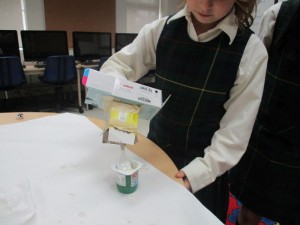I had been contemplating how to incorporate design thinking into the Junior School. I had done some reading over the summer. I also had some conversations with Joe Smith about the design cycle that he uses in the Middle School. I decided to use an older version of the MYP Design Cycle because it was simpler for the younger students.
The Grade 2s were doing a new unit with the following Central Idea: People with physical challenges use adaptation and innovation to access their communities. This seemed like the perfect place to start. During a planning meeting, I raised the idea of the students designing and creating a device for a person who could not used their fingers and thumb to be able to eat yogurt with a spoon.
I developed a format for the students to follow that included:
- Identifying the Problem
- Design Needs (Specifications)
- Design Ideas – space for sketching
- Materials
- Plan for Building/Creating
- Test
- Evaluation (based on specifications)
- Reflection
The students worked on their plan and their creations for a few weeks. At first, they seemed unsure of the expectation and of themselves and their ability to meet the expectations. I felt it was important to let the students experience these feelings and to find their way through the process. I gave them access to all of the materials while they were figuring out the problem and how to solve it. Just looking at the materials helped them to start generating ideas. Once they had time to chat with their partner or group, they started to sketch some designs. When they had a design they liked, then they showed me the design and explained how it would work. They were then free to start building. I added some math to the project by having them tell me how much of each material they wanted, for example, 20 cm of ribbon.
Listening to the students talking, testing, reconsidering, altering and improving their designs as they worked was the most interesting and most important part of the project. Once all of the designs were completed, we had our resident expert, Joe Smith, come over for the final testing and evaluation phase. Before the students attempted to scoop up yogurt and get it to their mouths, they had to explain their thinking to Joe. They were nervous but then very excited when their device worked. All of the students were successful, although many had ideas to improve their device.
The final stage was evaluating their devices based on their specifications. Each group had a chance to evaluate their device with Joe. The students were very proud of their accomplishments and wanted to share their learning with him.

The devices and the students’ plans are now on display for everyone to see. This experience definitely helped the students to gain a better understanding of the unit’s Central Idea.
As a first attempt at integrating design thinking into the curriculum, I would say that this was very successful. Now I am working on finding a way to authentically integrate design thinking into every grade level.


Cathy, your students must have felt like professional engineers. This project integrates so many skills that it is the whole package. Nicely done.
Cathy – Thanks for including me in the activity. Your students were very engaged and proud of their final designs as they tested them in a real life situation. I’m looking forward to the next project, and the students eventually coming to the middle and senior school with design thinking experiences!
Cathy — This is a fabulous project and one I’m sure your students aren’t likely to forget. This is an excellent example of student-centered learning at its best. Having students work through design plans, conference, rework, and then self evaluate with Joe adds a heightened layer of authenticity to their work. I am excited to see where next you take Design Thinking! Thank you for sharing.